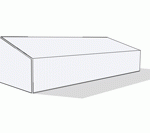13 Can Be Very Fortunate
Thank you for participating (hopefully) in my past dozen articles about our “NEW” Hansen Pole Building. If not, I would greatly to encourage you to peruse them. I believe you will find them useful in being able to know you are getting greatest value for your hard-earned building dollars.
In just a moment, I will peel back a curtain to reveal an overly well kept secret….. Hansen Pole Buildings has been automatically giving a background FIVE (5) % DISCOUNT for rectangular buildings with economical width and length dimensions.
But 1st, please humor me about 13. Our youngest daughter Allison, doesn’t get much press from me, certainly not by intention. Allison’s birthday happens to be November 13 and as an athlete (we did something like eight years of some combination of club or school volleyball and basketball) she always wanted and usually got #13.
I had always had an ideal Friday the 13th was unlucky due to it being tied to Knights Templar eradication on Friday, October 13, 1307. Before I wrote further, I wanted to confirm my belief. It appears there are both Norse and Christian associations long predating 1307.
My new thing learned for today.
Now your turn…..
Lumber comes in two foot multiples and steel roofing and siding three foot. Meaning multiples of six or 12 feet would be one’s most efficient combination.
 In our system widths of 12’, 18’, 24’, 30’, 36’, 42’, 48’, 54’ and 60’ are most cost effective. For lengths, 24’, 36’, 48’, 60’, etc., providing building length is no greater than three times building width. Heights – even number multiples of two feet (10’, 12’, 14’, etc.).
In our system widths of 12’, 18’, 24’, 30’, 36’, 42’, 48’, 54’ and 60’ are most cost effective. For lengths, 24’, 36’, 48’, 60’, etc., providing building length is no greater than three times building width. Heights – even number multiples of two feet (10’, 12’, 14’, etc.).
Why? They can go rapidly through our system – everyone who touches your project can do so more expediently. This drastically saves on drafting time, circumventing other shapes and/or dimensions.
Now you can have some custom features – windows, doors, wainscot, eave lights, sidewall eave and/or endwall extended overhangs, ceiling loaded trusses, ceiling joists.
I lay awake at night with ideas popping into my head. Last night it was, “given our new, stronger columns, how greatly is price affected?”
I took a 42’ x 60’ building, steel roofed and sided. Ground Snow load (Pg) of 60 psf (pounds per square foot), Roof truss top chord live load (TCLL) of 40 psf. Roof truss top and bottom chord dead loads both five psf. 115 mph design wind speed, Exposure C, 4/12 roof slope. Up to and including 20 foot eave height, each two feet of height added under 34 cents per cubic foot of space (or under 68 cents per square foot). Any ‘penalties’ for taller eave heights, at least to 20 foot tall, within this design load set, appear to have disappeared.
No one else can fully engineer buildings like a NEW Hansen Pole Building, because they do not have materials readily available to our exacting quality and strength standards. Call 1.866.200.9657 TODAY to participate in “The Ultimate Post-Frame Building Experience”.
And, don’t forget to watch for our next article!








